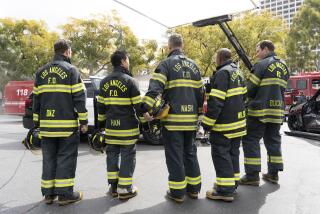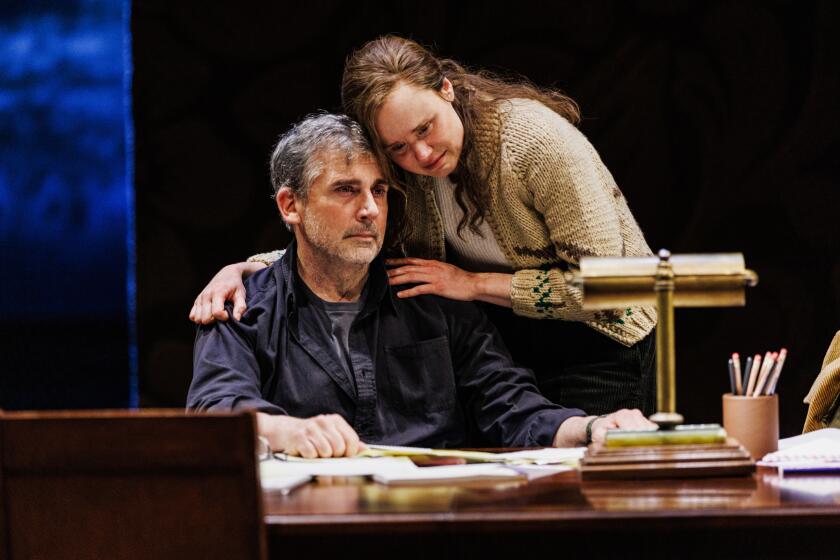A nest still in fine feather
Visit the Getty Center, and you can get a sense of what its fiscal overseers have experienced in five years of running it: a steep ride up and a steep ride down, all for the sake of an edifying encounter with art.
The tram ride to and from the hilltop museum and research complex in Brentwood is a mile-and-a-half round trip and doesn’t cost a cent. But the art institution’s up-and-down financial journey can be tallied in billions gained, lost and spent.
The market boom of the late ‘90s pushed the Getty’s endowment to its summit, $6.1 billion, during the summer of 2000. Since then, the market slide of the new century has shaken $1.7 billion out of one of the nation’s richest cultural piggy banks, leaving it at $4.4 billion -- or just about where it stood when the Getty Center opened in December 1997.
That’s OK with Barry Munitz, president of the J. Paul Getty Trust, which funds and operates the Getty Center.
Suppose a seer had appeared to him on Jan. 5, 1998, his first day on the job, and proposed a deal: You can spend an average of $284 million per year for the next five years -- enough to keep up the place, meet payrolls for a staff of about 1,300, pay off the construction debt, add to the art collection and conduct high-level academic research and art preservation projects. You’ll be able to share it all free of charge with 7.4 million visitors -- and you’ll still be sitting on a $4-billion-plus pile when the time is up.
“I would have signed that piece of paper in the morning,” Munitz says.
“It’s quite enviable,” says Ed Able, director of the American Assn. of Museums. “These are very, very stressful times for museums because all revenue sources have been undermined simultaneously,” leading in some cases to staff cutting and the closing of galleries. Meanwhile, the Getty Center sits in relative fiscal serenity atop its hill and its mountain of cash.
“The stability of their funding,” says Able, “means they don’t have to generate the kinds of outside income that other museums must generate.”
Despite that nice cushion, the Getty Trust faces the same economic uncertainties as every other investor, and some major expenses loom. The long-delayed renovation project at the Getty Villa in Pacific Palisades is estimated to cost $250 million. (See accompanying box.) If it goes forward, the plan is to borrow that sum and pay it down long term, at interest rates projected at 2% or less. But when the villa reopens -- two years from now under the current timetable -- the operating expense, which Munitz estimates at $30 million a year, will be immediate.
“It’s our main financial challenge,” he says.
There’s also a $50-million painting in the pipeline -- the Getty Trust having agreed to pay the British owner of Raphael’s “Madonna of the Pinks” that sum, unless some buyer in the U.K. can match it under a government program designed to keep historic artworks on British soil. The Getty won’t divulge what it spends on art acquisition, but Munitz says it steadily has exceeded the $30.6-million annual average that New York’s Metropolitan Museum of Art reported in public financial statements for the three fiscal years from 1999 to 2001. Private collectors, rather than other museums, are the Getty’s most formidable bidding rivals.
“Everybody’s always telling me, ‘Boy, it’s great to be able to get anything you want,’ ” Munitz says. “Most of the things we’ve gone after lately we haven’t gotten. We stay disciplined, and we just won’t go any higher than what we think the right price is. Private collectors don’t necessarily work that way. They have the money, they like something, and they don’t have to [worry about] paying the electric bill for the tram.”
The Getty’s self-set ceiling for all its annual spending is 5% of its endowment’s average value over the previous three years. The investment strategy calls for betting about 60% to 65% of the endowment on stocks and an additional 5% to 10% on “alternative investments” such as private equities and venture capital opportunities. About 30% stays in conservative fixed-income securities such as government and corporate bonds and federally insured mortgage pools. Munitz says the Getty Trust has a series of indexes and benchmarks it uses to rate how its investments are performing. Overall, he said, during the downturn the trust’s returns have bettered those standards by about 1.5%.
“I’m comfortable, but not pleased, with how well we’re doing vis-a-vis the benchmarks. I think we can do better,” he says. To that end, he says, the Getty Trust is hiring an in-house finance expert whose job will be strictly to track the portfolio and work with the 17 outside investment professionals who manage the endowment. Until now, two Getty finance executives had divided their attention between investments and other fiscal chores such as budgeting and operating expenditures.Peter Frumkin, a Harvard professor who studies nonprofit organizations, says the Getty Trust’s investment strategy is “a little bit more aggressive” than the 60-40 split between stocks and fixed-income investments he says is typical for major institutional investors such as universities, hospitals and foundations, “but well within the normal parameters.”
In the mid-’90s the Getty briefly stepped outside those parameters and took a $400-million hit when it bet that the market would go down. Instead the market went up. At the time, Getty officials said they wouldn’t repeat that sort of unorthodox maneuver.
Among charitable foundations, the Getty Trust’s assets rank fifth nationally, according to a survey by the Foundation Center, a New York-based research organization. The Getty endowment’s rise during the good times -- and the 27.6% dip it has taken during the two most recent years of market declines -- jibe with the experience of other large foundations, experts say.
The Getty’s endowment declines are “probably within the middle of the bell curve,” says Dorothy Ridings, president of the Council on Foundations, a national service organization based in Washington, D.C.
The David and Lucile Packard Foundation, which invested mainly in Hewlett-Packard stock, saw its endowment suffer a two-year drop from $15 billion to $3.8 billion. The Lilly Endowment, invested wholly in Eli Lilly and Co. drug stock, declined in two years from $15.6 billion to $10.2 billion. The Ford Foundation, which pursues a broad-based investment strategy, saw its investment assets shrink from $14.5 billion to $8.3 billion over a similar span, a 37% decline. The Bill & Melinda Gates Foundation, the nation’s largest, has dropped $1 billion in value during 2002, standing at $23.9 billion as of Oct. 31. As with the Getty Trust, those declines are not purely from market losses, but also reflect ongoing philanthropic spending.
Munitz has asked Getty department heads to propose ways to economize for the coming fiscal year. Still, he says, barring a prolonged U.S. economic decline , “I would be amazed if there was anything dramatic” that the Getty would cut, such as slashing staff and programming. If the endowment suffers further investment losses, the Getty has the built-in flexibility to cope through difficult times, Munitz says. It can buy less art, or it can cut back on its relatively modest grant-making program, which has risen from $10.6 million to $19.2 million annually over the past five years.
But sitting still atop the pile would be a mistake, Munitz says. Four years ago, he and other trust officials said publicly that it would be prudent for the Getty Trust to start seeking donations rather than just clipping coupons on the endowment. That notion raised protests from some other cultural organizations. If anything, the Los Angeles County Museum of Art’s director, Andrea L. Rich, said at the time, the Getty should be sharing more of its considerable wealth instead of trying to hit up a limited pool of arts donors for even more.
Munitz thinks the market’s downturn, and the two-year shrinkage of the pile, vindicates what he said back then, and that’s why the Getty Trust is moving ahead with fund-raising now. According to its financial reports, the trust took in only $8.7 million in contributions -- much of it the valuation of donated art -- during the five fiscal years ending last summer.
But now, Munitz says, prospective board members are being scouted for, among other attributes, their ability to make or generate donations. The Getty also has established two councils for donors who want to support the villa project and the center’s painting conservation program. So far, 41 have signed up, to the tune of $5,000 a year each, and similar support groups for other operations are planned.
A year and a half ago the Getty hired a fund-raising specialist to pursue corporate giving, Munitz said, and another development hire is in the pipeline. Aims include generating more gifts of art and cash, securing sponsorships for exhibitions and educational programs, finding donors who would like their names emblazoned on facilities in exchange for large sums, and renting out the hilltop for corporate functions.
Fears that the Getty will siphon off donations that otherwise would go to needier institutions “make no sense,” Munitz said. “It’s not a zero-sum game. It’s all boats rising.”
LACMA’s Rich had no comment.
“It’s very bizarre, but for years people have come to us wanting to give money, and we’ve said no,” Munitz says. “We’re going to stop saying no. And people will give us art, and they will give us money, given our strength.”
*
(BEGIN TEXT OF INFOBOX)
The money behind the art
Operating expenditures of major American fine arts institutions in 2000-01.
Metropolitan Museum of Art (New York City) -- $244.1 million
J. Paul Getty Center -- $241.1 million
Art Institute of Chicago -- $175.1 million
Museum of Fine Arts (Boston) -- $104.7 million
Los Angeles County Museum of Art -- $49.9 million
Source: IRS Form 990s
More to Read
The biggest entertainment stories
Get our big stories about Hollywood, film, television, music, arts, culture and more right in your inbox as soon as they publish.
You may occasionally receive promotional content from the Los Angeles Times.







